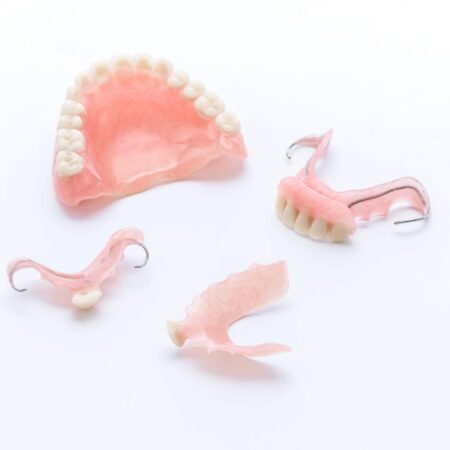
If you’re experiencing chronic pain or other types of discomfort involving your jaws, it’s possible you’re suffering from temporomandibular disorders (TMD). TMJ Disorder refers to problems associated with the jaw joint, also known as the temporomandibular joint (TMJ), and the surrounding tissues—with symptoms ranging from slight discomfort to severe pain.
There are different approaches for treating TMD that vary from one dental professional to another. Basic knowledge of TMD and the variety of treatment options often used can be very beneficial as you pursue relief from this disorder.
Symptoms of TMJ Disorders
The temporomandibular joint is located at the intersection of the lower jaw (mandible) and the lower part of the skull (temporal bone); it allows vertical and horizontal movement of the lower jaw. A TMJ is a “ball and socket” joint with a cushioning disk that rests between the mandibular ball (the condyle) and the socket in the temporal bone.
Clicking Sound at the Joint
When the joint and attending muscles and ligaments exhibit symptoms of pain and dysfunction, we refer to it as a temporomandibular disorder. One such symptom is a clicking sound at or near the joint, caused by the disk shifting inside the joint. Persons standing nearby may hear the sound, and you may even feel it when placing your fingers on your face just in front of the ears. An estimated one-third of all people experience this click, with most not having any accompanying problems. Therefore, in most cases, treatment isn’t necessary. However, if the click accompanies pain or if you feel that your jaw is stuck in either an open or closed position, you should seek medical attention.
Muscle Pain and Stiffness
Muscle pain is another major symptom of TMD, especially if felt in the cheeks or temples where the two large jaw muscles are located. If the pain seems more intense upon waking in the morning and accompanied by jaw stiffness, it could be a symptom of teeth clenching, a chronic habit of biting down, or teeth grinding, a chronic habit of moving the teeth against each other that often occurs during sleep. You can wear an occlusal nightguard at night, designed specifically to fit your teeth and jaw movements. This nightguard helps prevent your teeth from forcefully contacting each other during sleep. This nightguard helps prevent your teeth from forcefully contacting each other during sleep.
Sharp Pain from the Joint
Another common symptom is a sharp pain from the joint itself. As with other joints, this type of pain is typically classified as arthritis, for which there is no known cure. In this case, it’s best handled by managing symptoms through medication, rest, soft diet and physical therapy. In a few instances, severe cases may benefit from cortisone injections or lavage, a procedure that flushes debris from the joint.
Finding the Right Treatment Pathx
While pain symptoms may indicate TMD, it’s also possible they originate from other areas of the body. The jaw joints share similar nerve networks with the teeth and sinuses, as well as neck and back muscles; the pain you feel near your jaw may result from radiated pain from one of these other locations. Before making the assumption that you have TMD, you should first visit your dentist to rule out other causes.
Two Approaches to TMD Treatment
If you receive a diagnosis of TMD, you should familiarize yourself with the treatment approaches your dentist may take. There exist, in actuality, two schools of thought for treating jaw joint disorders. The more respected and popular approach views TMD as primarily a joint problem that should be treated orthopedically as you would other joint problems.
These kinds of treatments are more conservative and less invasive than those used in the more aggressive approaches: the use of medications for pain and to relax rigid muscles; physical therapy, massage or light stretching to exercise and strengthen the joint muscles; or cold and hot alternating therapies using ice and warming packs applied to the jaws to relieve pain and relax the muscles. Since most TMD problems are stress-related, it is advisable to start with this approach, considering that all of these treatments are reversible. As the dentist evaluates your response to treatment, he can gradually consider more irreversible treatment options.
The Traditional Approach
The more traditional approach used in the past was based on the belief that jaw muscle pain arises primarily from the dysfunction caused by bad bites (malocclusions), disruptions related to missing teeth, or jaw misalignments. The treatments used in this approach aim to correct the dysfunction as a way to relieve the pain and other symptoms felt in the jaw: orthodontics to correct malocclusions, and teeth crowning or reshaping, for example. All of these will result in permanent changes to the teeth or mouth structure, but with no assurance of significant relief of TMD symptoms.
While both of these approaches have merits, the orthopedic view is today’s more accepted perspective and most commonly preferred as the beginning point for treatment. Becoming acquainted with both views and their associated treatments for TMD will help you have a more informed discussion with your dentist or physician about your treatment plan and options.
TMD-related pain and reduced function can make daily life difficult or even debilitating—and finding the right treatment mix that effectively relieves your symptoms can be just as difficult. But knowing about the treatments used, as well as the background for using them, will help you better navigate through these various options and find effective relief from TMD.
May also interest you / Bone Grafting for Dental Implants.














Leave a Reply